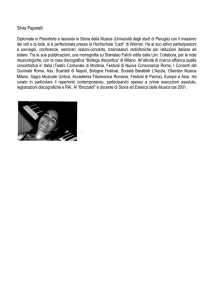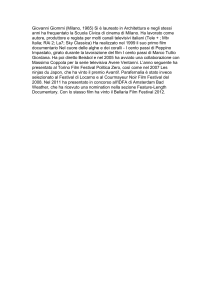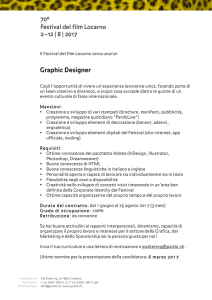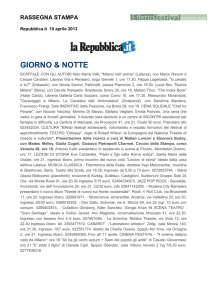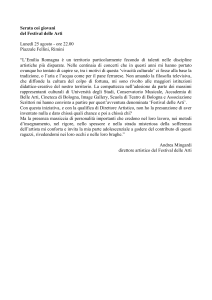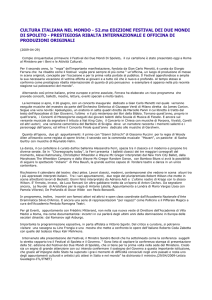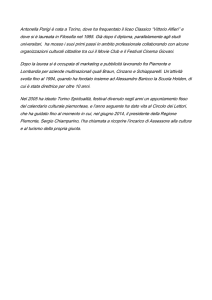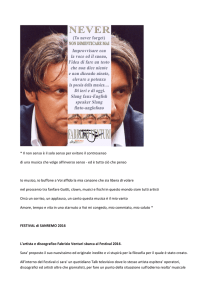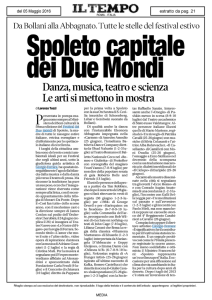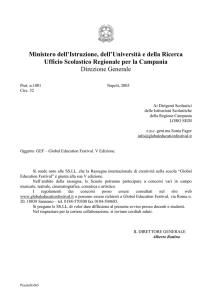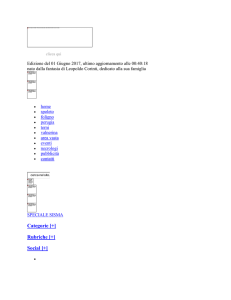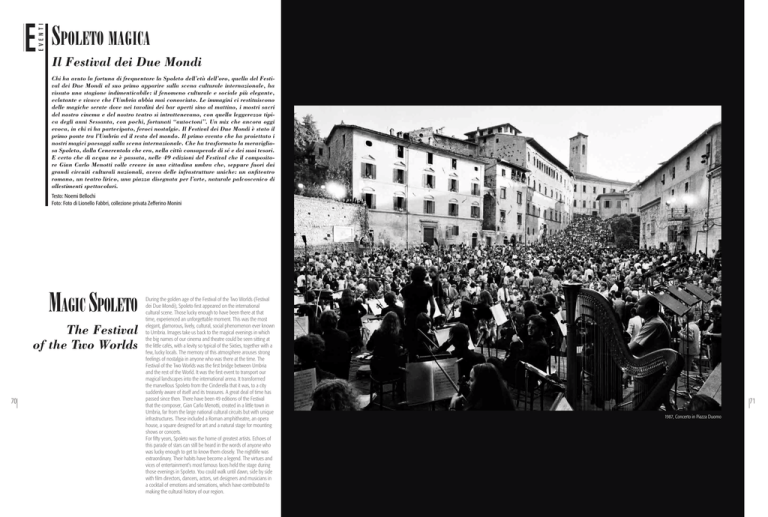
eventi
e
Spoleto magica
Il Festival dei Due Mondi
Chi ha avuto la fortuna di frequentare la Spoleto dell’età dell’oro, quella del Festival dei Due Mondi al suo primo apparire sulla scena culturale internazionale, ha
vissuto una stagione indimenticabile: il fenomeno culturale e sociale più elegante,
eclatante e vivace che l’Umbria abbia mai conosciuto. Le immagini ci restituiscono
delle magiche serate dove nei tavolini dei bar aperti sino al mattino, i mostri sacri
del nostro cinema e del nostro teatro si intrattenevano, con quella leggerezza tipica degli anni Sessanta, con pochi, fortunati “autoctoni”. Un mix che ancora oggi
evoca, in chi vi ha partecipato, feroci nostalgie. Il Festival dei Due Mondi è stato il
primo ponte tra l’Umbria ed il resto del mondo. Il primo evento che ha proiettato i
nostri magici paesaggi sulla scena internazionale. Che ha trasformato la meravigliosa Spoleto, dalla Cenerentola che era, nella città consapevole di sé e dei suoi tesori.
E certo che di acqua ne è passata, nelle 49 edizioni del Festival che il compositore Gian Carlo Menotti volle creare in una cittadina umbra che, seppure fuori dai
grandi circuiti culturali nazionali, aveva delle infrastrutture uniche: un anfiteatro
romano, un teatro lirico, una piazza disegnata per l’arte, naturale palcoscenico di
allestimenti spettacolari.
Testo: Noemi Bellochi
Foto: Foto di Lionello Fabbri, collezione privata Zefferino Monini
Magic Spoleto
The Festival
of the Two Worlds
70
During the golden age of the Festival of the Two Worlds (Festival
dei Due Mondi), Spoleto first appeared on the international
cultural scene. Those lucky enough to have been there at that
time, experienced an unforgettable moment. This was the most
elegant, glamorous, lively, cultural, social phenomenon ever known
to Umbria. Images take us back to the magical evenings in which
the big names of our cinema and theatre could be seen sitting at
the little cafés, with a levity so typical of the Sixties, together with a
few, lucky locals. The memory of this atmosphere arouses strong
feelings of nostalgia in anyone who was there at the time. The
Festival of the Two Worlds was the first bridge between Umbria
and the rest of the World. It was the first event to transport our
magical landscapes into the international arena. It transformed
the marvellous Spoleto from the Cinderella that it was, to a city
suddenly aware of itself and its treasures. A great deal of time has
passed since then. There have been 49 editions of the Festival
that the composer, Gian Carlo Menotti, created in a little town in
Umbria, far from the large national cultural circuits but with unique
infrastructures. These included a Roman amphitheatre, an opera
house, a square designed for art and a natural stage for mounting
shows or concerts.
For fifty years, Spoleto was the home of greatest artists. Echoes of
this parade of stars can still be heard in the words of anyone who
was lucky enough to get to know them closely. The nightlife was
extraordinary. Their habits have become a legend. The virtues and
vices of entertainment’s most famous faces held the stage during
those evenings in Spoleto. You could walk until dawn, side by side
with film directors, dancers, actors, set designers and musicians in
a cocktail of emotions and sensations, which have contributed to
making the cultural history of our region.
71
1987, Concerto in Piazza Duomo
Spoleto per cinquant’anni ha risuonato dei passi degli artisti più grandi. E ancora oggi l’eco di questa parata di stelle risuona nelle parole di chi ha avuto
modo di conoscerli da vicino. La vita notturna era straordinaria. Le loro abitudini, rimaste leggendarie. I vizi e le virtù dei volti più noti dello spettacolo
tenevano banco nelle notti spoletine, dove sino all’alba si passeggiava fianco a
fianco con registi, ballerini, attori, scenografi, musicisti, in un cocktail di emozioni e suggestioni che ha fatto la storia culturale della nostra regione.
II Festival oggi
Ora che l’era del suo patròn è terminata, ora che di Giancarlo Menotti son
rimaste le opere, le fotografie, le memorie di una città che gli deve praticamente tutto, ed ora che si sono spente, alla fine, anche le polemiche seguite
al passaggio di consegne dal padre adottivo al figlioccio Francis, è tempo di
ritrovare una nuova identità. E di partire con rinnovato slancio, trovare nuove
strade, riproporre un festival altro da sé. Una nuova stagione di eventi culturali
che non cerchi di copiare l’irripetibile, ma che crei nuove suggestioni. è quanto
coraggiosamente sta facendo il nuovo direttore artistico, Giorgio Ferrara. Uno
dei pochi, il cui smagliante curriculum non è stato messo in ombra dall’ombra
titanica dell’ideatore del Festival. Un artista che ha avuto il coraggio di accettare
una sfida ardua e difficile: e ridato smalto ad una manifestazione, che crisi economica, tensioni politiche, scelte artistiche non sempre condivise, rischiavano
di far ripiegare su se stessa.
Ma qual è stato il percorso che ha portato le massime istituzioni culturali italiane ad insediare un regista come Ferrara alla guida del Festival umbro? Si possono riassumere tre tappe fondamentali. La prima, indubbiamente, consisteva
nell’esigenza forte di rilancio e riqualificazione. Già l’allora Ministro dei Beni
culturali Francesco Rutelli, regista di questo insediamento, aveva sottolineato
come il passato glorioso del Festival “obbligasse” in pratica a ricostruire quella
fama internazionale originaria, restituendo alla città ed all’evento il suo ruolo di
vetrina di prestigiose creazioni.
Secondo, l’evidente possibilità di dar luogo - in
una città dagli scenari prestigiosi come Spoleto, ad ambientazioni uniche, e di
conseguenza, a produzioni culturali di grande visibilità.
Terzo, la necessità di
tornare a coinvolgere artisti di fama nel campo del teatro, dell’arte lirica, della
musica e del balletto per proporre “riletture” del grande repertorio.
A rispondere a questo appello, nelle edizioni di Ferrara, nomi celebri per la
loro inventiva, ma soprattutto per la loro curiosità. Registi cinematografici chiamati a modernizzare l’opera lirica, registi di teatro spronati a rileggere i classici, apertura anche ai più giovani. Il nuovo Festival ha rappresentato una chiave
di libertà e una garanzia di altissima qualità.
I luoghi del Festival
Ma quali sono i luoghi che hanno fatto di Spoleto la città ideale per una rassegna
artistica? Alla spettacolare scenografia di piazza del Duomo, si aggiunge l’anfiteatro romano, il Teatro Lirico Belli, le sale espositive delle dimore storiche, i circuiti
museali. Vale la pena citare Palazzo Collicola con la Galleria d’Arte Moderna, la
Rocca Albornoziana, al cui interno è presente un grande teatro all’aperto, le sale del
Museo del Ducato, i cui spazi si prestano all’utilizzo per mostre di arti visive, Palazzo
Mauri, utilizzato per le attività seminariali di ricerca drammaturgica.
E ancora, il
Teatro Nuovo di recente ristrutturazione, il Teatro Caio Melisso, il Teatro Romano, il
Teatrino delle Sei (con archi a volta di grande suggestione), l’Auditorium della Stella
nell’ex Chiesa dei Santi Stefano e Tommaso. Tutti luoghi ideali, dove creare nuovi
spettacoli, e nuove generazioni di spettatori.
1967, Ezra Pound e Olga Rudge alla finestra di casa Menotti durante il Concerto in Piazza Duomo
72
The Festival TODAY:
The era of its patron is now over. The only things
remaining of Giancarlo Menotti are his works, photos
and memories of a town that owes almost everything
to him. Even the controversy following the handover
from adopted father to godson, Francis, has died down.
It is time to find a new identity, new energy, and new
paths and propose a different kind of Festival. A new
season of cultural events is needed and it must be one
that doesn’t try to copy what can’t be repeated. This is
what the new artistic director, Ferrara, is bravely trying
to do. His dazzling curriculum vitae was one of the few
that doesn’t disappear under the colossal shadow of
the Festival’s creator. He is an artist brave enough to
accept a difficult challenge, giving back some shine and
a future to this event. In fact, as a result of the economic
difficulties of recent years, the political tension and
controversial artistic choices, the Festival has risked
falling back on itself.
So, why did the major Italian cultural institutions put
a director like Ferrara at the helm of this Umbrian
Festival? There have been three fundamental stages.
The first was undoubtedly the strong need for relaunch
and renewal. The Minister of Cultural Heritage at that time
was Francesco Rutelli. Remembering the glorious past of
the Festival, he had underlined the importance of restoring
its original international reputation, giving this showcase
of prestigious creations back to the town and to the event
itself. The second stage was the obvious potential of a
renowned town like Spoleto, in which unique settings
and, consequently, high visibility cultural productions can
be held. The third stage was the need to engage famous
artists from the worlds of theatre, opera, music and ballet to
present new readings of the great repertoire of the past.
The appeal of Ferrara’s editions of the Festival brought in
big names who were famous for their inventiveness and
above all for their curiosity. These included film directors,
who were invited to modernize the opera and theatre
directors, invited to reinterpret the classics. The Festival was
also opened up to a younger audience. The new Festival
was the key to freedom and a guarantee of high quality.
The Festival venues
Which places in Spoleto made it the ideal town for
an artistic Festival? As well as the spectacular piazza
del Duomo square, there is the Roman amphitheatre,
the Belli opera house, the exhibition halls of the toric
dwellings and the museum circuits. Other places
worth mentioning are the Palazzo Collicola building
and the Gallery of Modern Art, the fortress of Rocca
Albornoziana, which houses a large open-air theatre,
and the Museo del Ducato museum, with its halls that
are ideal spaces for art exhibitions. There is also Palazzo
Mauri, a building used for seminars and activities of
dramaturgical research, the recently renovated Teatro
Nuovo (New Theatre), the Teatro Caio Melisso theatre,
the Roman Theatre (Teatro Romano), the Teatrino delle
Sei theatre with its evocative vaulted arches and the
Auditorium della Stella, inside the former Church of St.
Stephen and St. Thomas. These are all ideal settings for
new shows to be held in and for new generations of
spectators.
The latest editions
The aim of the Festival today, therefore, is not to launch
itself into sad, nostalgic trips down memory lane, but to
look to the future. Nevertheless, it is doing this without
forgetting its origins. Looking at the last edition in 2011,
you notice that the strength of the Festival was that it
coincided with the 150th anniversary of the Unification
of Italy and also with the 100th anniversary of the birth
of its creator and was a tribute to his memory.
73
1966, Il maestro Gian Carlo Menotti con i suoi collaboratori durante le prove di Pelléas et Mélisande
Le ultime edizioni
Oggi, quindi, lungi dal lanciarsi in operazioni nostalgiche e tristi amarcord, il Festival
guarda avanti. E lo fa senza dimenticare le sue origini. Guardando all’ultima edizione,
quella del 2011, ci si accorge che il punto di forza dell’anno che ha coinciso sia con
il 150ennale dell’Unità d’Italia, sia con il 100 mo anniversario della nascita del suo ideatore, è stato l’omaggio alla memoria. Il Festival ha ricordato Menotti con la messa
in scena del suo “Amelia al ballo”, opera buffa in atto unico, scritta dal compositore
all’età di 27 anni. Un duplice omaggio, all’Italia ed al Maestro, mai dimenticato. Perché
la memoria deve spronare, e non essere limitante. “150 anni per un Paese solo. Ma
secoli e secoli per i suoi mille luoghi, per le sue mille contrade. E dovunque la bellezza
racchiusa nelle pietre, la realtà teatrale della vita, l‘armonia di suoni sempre nuovi.
Come qui. Come in questa città. Di questo paese”. Così Giorgio Ferrara descriveva
i principi imprescindibili che hanno animato il suo Festival, nella passata edizione.
Per capirne l’essenza, sarà necessario tuttavia spendere due parole per descrivere il
personaggio. Ferrara, nato a Roma nel 1947, ha passato parte dell’infanzia a Mosca.
Ha seguito il corso di laurea in Lettere e filosofia presso l’Università la Sapienza di
Roma e si è diplomato all’Accademia Nazionale d’Arte Drammatica “Silvio d’Amico”. è
stato aiuto-regista di Luca Ronconi e di Luchino Visconti, con i quali ha intensamente
collaborato. In particolare, ha assistito il Maestro in Ludwig, e in Old times di Harold
Pinter.
Per il teatro ha messo in scena numerosi spettacoli di autori classici e contemporanei come Pirandello, Strindberg, Goldoni Carlo Bernari, Francesca Sanvitale,
Enzo Siciliano, Franca Valeri, Cesare Musatti, Natalia Ginzburg e Corrado Augias.
Per
il cinema ha diretto “Un cuore semplice”, (tratto da Gustav Flaubert, sceneggiatura di
Cesare Zavattini) ottenendo il Davide di Donatello. E ancora, Premio Rizzoli, Premio
Saint Vincent, Nastro d’argento.
Per la televisione ha realizzato 8 film per la RAI. Dal
1987, vive tra Roma e Parigi, con sua moglie, l’attrice Adriana Asti. Direttore dell’Istituto Italiano di Cultura di Parigi (2003-2007) e presidente del Ficep Forum des Instituts
Cultures étrangers à Paris (2005-2007).
Hanno scritto
“Giancarlo Menotti è un mediocre compositore del
Novecento interessato più alla vita mondana con
titolate e miliardarie che alla musica. Il suo catalogo
è scarso e fatto di acqua fresca. Va ricordato tuttavia
perché ebbe l’idea di fondare nel borgo medioevale di
Spoleto, raccolto attorno a una piazza ove campeggia
un maestoso Duomo, il Festival dei due Mondi. I più
grandi artisti del teatro, della musica (Thomas Schippers
è seppellito in una pietra della Piazza), delle arti
figurative, delle avanguardie, della scultura astratta in
bronzo, della fotografia, passarono di lì. L’atmosfera,
negli Anni Cinquanta e Sessanta, era quella di «prime»
indimenticabili e spruzzi d’inane fantasia non destinata a
rispondere a nessuna legge, clown e severa avanguardia,
gran mondo internazionale, quelle che oggi si costuma
dire «trasgressioni» e omosessualità. Totò ne fa, con la
suprema Franca Valeri, una trasposizione a Capri in un
episodio di Totò a Colori. Menotti non morì. Si distinse
nell’arte nella quale più eccelleva, la regia. Ricordo un
meraviglioso Eugenio Onegin di qualche anno fa. Poi
la Parca se lo portò via; pure Schippers, che del Festival,
dal punto di vista musicale, quello che contava di più,
era il punto di riferimento; morì Visconti, già costretto
dalla malattia a sopravvivere a se stesso. Vennero anni
bui e turbolenti. Poi il Festival rinacque nelle mani di
Giorgio Ferrara, che attualmente ne è il Presidente, e
di Alessio Vlad, direttore artistico, anche se la pecunia
governativa è sempre più scarsa e vecchi fantasmi, misti
di «generone» romano, ne attraversano ora spauriti, ora
ardimentosi, le inaugurazioni”.
Paolo Isotta, Corriere della Sera, 30 giugno 2011
1973, Thomas Schippers e Luchino Visconti in un palco del Teatro Nuovo durante le prove della Manon Lescaut
74
The Festival paid tribute to Menotti by
staging his Amelia al ballo (Amelia goes to
the ball), a comic opera in one act, written
by the composer when he was 27 years
old. This was a double tribute to Italy and
to the unforgettable Maestro. Memories
must inspire and not limit. “150 years to
celebrate one Nation, yet its thousands of
locations and thousands of districts have
been here for numerous centuries. Its beauty
is everywhere, in the stones, in the theatrical
reality of life, in the harmony of new sounds.
Like this place, this town, this country.”
This is how Giorgio Ferrara described the
essential principals that animated the last
edition of his Festival. To understand the
essence of this, though, a few words are
needed to describe this personality. Ferrara
was born in Rome in 1947 and spent part
of his childhood in Moscow. He attended
a degree programme in literature and
philosophy at the “la Sapienza” University
of Rome and he obtained his diploma at
the “Silvio d’Amico” National Academy of
Dramatic Arts. He was assistant director to
Luca Ronconi and Luchino Visconti with
whom he enjoyed an intense collaboration.
In particular he assisted Maestro Visconti
in “Ludwig” and in “Old Times” by Harold
Pinter. He has staged numerous theatre
plays, by both classical and contemporary
authors like Pirandello, Strindberg, Goldoni,
Carlo Bernari, Francesca Sanvitale, Enzo
Siciliano, Franca Valeri, Cesare Musatti,
Natalia Ginzburg and Corrado Augias.
He
also worked in cinema, directing the film
“A Simple Heart” (by Gustav Flaubert,
screenplay by Cesare Zavattini), receiving the
Davide di Donatello film award, the Premio
Rizzoli award, the Saint Vincent award and
the Nastro d’Argento award... He also made
8 television films for RAI TV (Italian National
TV). He has been living between Paris
and Rome since 1987 with his wife, actress
Adriana Asti. He was Director of the Italian
Institute of Culture in Paris (2003-2007) and
president of the Ficep Forum des Instituts
Cultures étrangers in Paris (2005-2007).
What they write about him
“Giancarlo Menotti was a mediocre composer of the
Twentieth Century, who was more interested in mundane
life of noblewomen and milionairesses than in music. His
catalogue is poor and made up of nothing. Nevertheless,
he must be remembered for his idea to create a Festival
in the mediaeval village of Spoleto, in the square where a
majestic Cathedral stands. This was the “Festival dei due
Mondi” (Festival of the two Worlds). The greatest artists of
theatre, of music (Thomas Schippers is buried under one
of the square’s stones), of figurative arts, of avant-garde,
of abstract bronze sculpture and of photography, all came
through here. The atmosphere of the Fifties and Sixties
was that of unforgettable ‘film premiers’ and splashes of
inane and ungoverned fantasy, clowns, heavy avant-garde,
the great international world and what today would be
called ‘transgresson’ and homosexuality. The legendary
Neapolitan actor, Totò, transposed all this, together with the
great Franca Valeri, on the island of Capri, in an episode
of ‘Totò a Colori’ (Totò in Colour). Menotti never died. He
distinguished himself in directing, the art he was best at. I
remember a marvellous Eugenio Onegin a few years back.
Then fate took him away and Schippers too. From a musical
viewpoint the important elements of the Festival were its
anchor points. Visconti died, already forced by his illness to
almost outlive himself after which turbulent and dark years
soon arrived. But then the Festival was born again, in the
hands of Giorgio Ferrara, its current President, and Alessio
Vlad, artistic director, even though government money is
increasingly scarce and the old ghosts of the past, mixed
with the Roman ‘generone’, frightened one minute and
daring the next, still pass through the inaugurations”.
Paolo Isotta, Corriere della Sera, 30th June 2011
75
1980, Carla Fracci nella Maratona internazionale di danza

